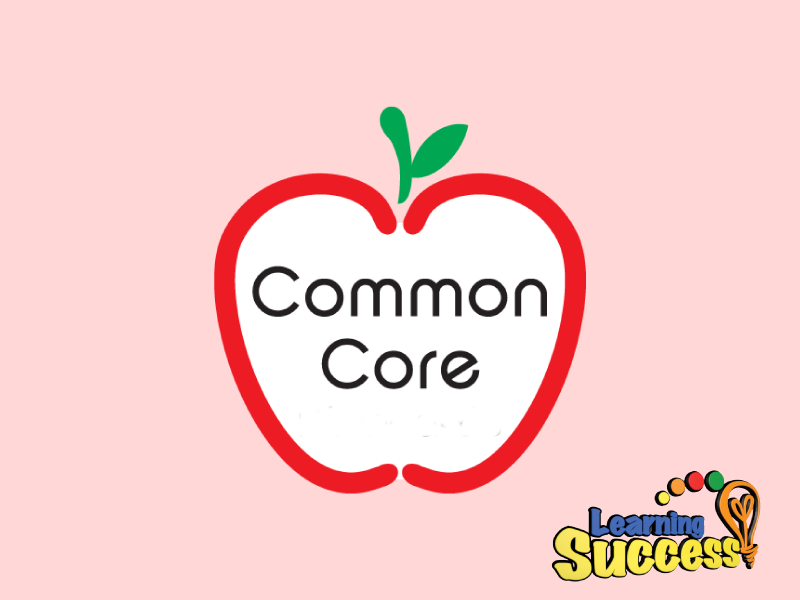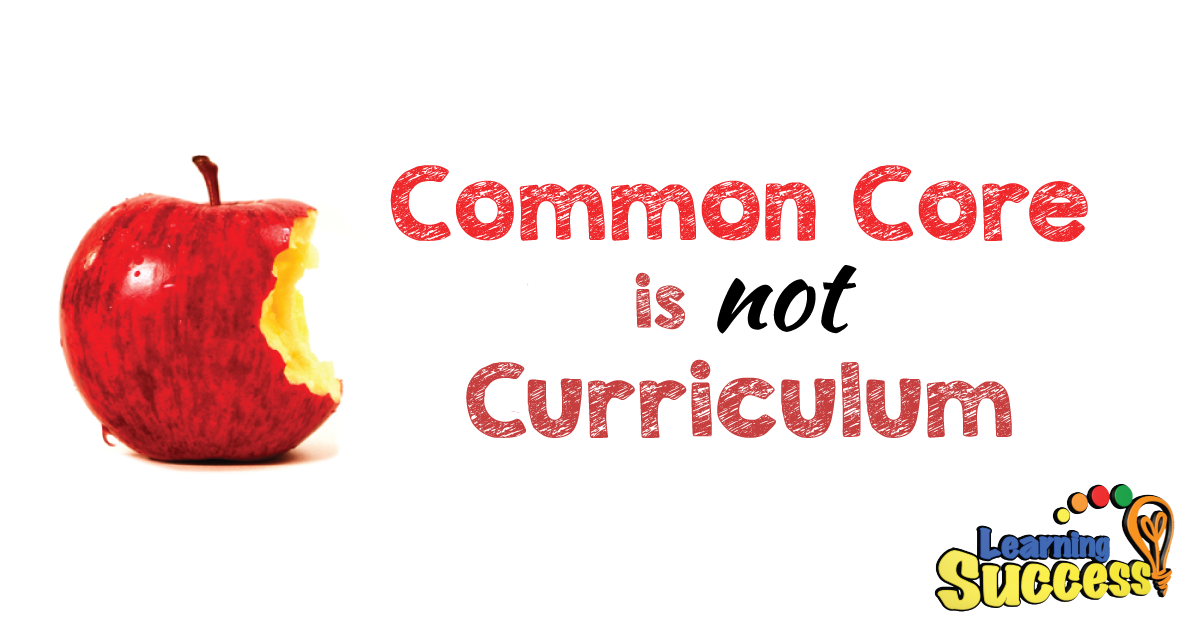
To be frank, I am frequently frustrated by the nature of the debate regarding Common Core. While I may not be thrilled with many states' application of Common Core (like much of America) or how much of the curricula have supposedly adapted themselves to Common Core, these, quite simply put, are not Common Core.
However, both advocates and opponents seem to put a lot of time into debating curriculum, when supposedly debating the Common Core. I hear comments like, “Look at how confusing this Common Core textbook is!” or “Can you see how much critical thinking this Common Core curriculum promotes?”
Time out. There are no Common Core curricula or textbooks. None.
Here's a video claiming to compare a 4th grade Common Core method of teaching multiplication with the old-fashioned way.
Hold on, I taught that method before Common Core in order to meet former state standards. It wasn't required, but it was one of the ways I could get my students up to the standard at that time. The same is true today. It's a method you can use, if you'd like, but it's not proscribed in the Common Core Standards.
Would you like to see Common Core? You can read the entire Common Core here. I know, I know, all it says is what children should learn at various grade levels, but that's all there is, really. It's a must-read for teachers, but it's probably not a bad read for parents either.

Defining Common Core
So what is Common Core?
Standards. That's it. They just say what a child should learn and be able to do by when. And only for English language arts and mathematics. Sorry, any of the supposedly Common Core science or history concerns are total bogus. They're not Common Core, because there is no science Common Core. They're usually just poorly written curriculum.
Are they good standards?
As a teacher from Louisiana (one of the lowest ranking states educationally in the nation), I like them a lot. They're more specific, clear, rigorous, and feasible (most of the time) than to what I was previously accustomed. If you're from a state that already had excellent standards, your state might not even have chosen to join Common Core, or if it did, they might look a lot like your past standards.
If you really want to know whether or not you like the standards yourself, you're going to need to compare the old with the new. Unfortunately, it would be a bit of a long article if I compared the standards of all fifty states to the Common Core. For the sake of this comparison, let's not use a high-performing or low-performing state as our example. Since Virginia ranks about the middle of the country (26th according to the Report Card on American Education), it should work fairly well.
Virginia's 2009 Mathematics Standards of Learning vs. Common Core State Standards
Take this as our first example. This is actually the 4th grade standard that was indicated in the video I mentioned above claiming to compare the Common Core method with the past method. What do you think? Is there one method for each?
|
Common Core |
Virginia's SOL |
|
Use place value understanding and properties of operations to perform multi‐digit arithmetic (4th grade Math Standards 4-6) · Fluently add and subtract multi‐digit whole numbers using the standard algorithm. · Multiply a whole number of up to four digits by a one‐digit whole number, and multiply two two‐digit numbers, using strategies based on place value and the properties of operations. Illustrate and explain the calculation by using equations, rectangular arrays, and/or area models. · Find whole‐number quotients and remainders with up to four‐ digit dividends and one‐digit divisors, using strategies based on place value, the properties of operations, and/or the relationship between multiplication and division. Illustrate and explain the calculation by using equations, rectangular arrays, and/or area models. |
4.4 The student will · estimate sums, differences, products, and quotients of whole numbers · add, subtract, and multiply whole numbers · divide whole numbers, finding quotients with and without remainders · and solve single‐step and multistep addition, subtraction, and multiplication problems with whole numbers. |
It is true Common Core states some methods a student should be able to utilize, though it's the student's choice which one to use (note: “equations, rectangular arrays, and/or area models”). I would find it gravely negligent of a teacher to ignore the equations method (that's your standard algorithm) when teaching, but ultimately under Common Core the student should be exposed to enough methods to choose one or two he/she likes to use.
All about specifics
As a teacher, the Virginia standards on the right provide little guidance to me (or to the parent). I suppose I realize the child should be able to add, subtract, multiply, and divide, but it's less clear to me how much more the child should be able to than the year before, when the child was also learning to add, subtract, multiply, and divide. I also am not made aware of the different methods the child could potentially use.
I teach kids with special needs, and this is major.
A lot of times the standard algorithms just didn't work for my children. They couldn't hold all those numbers in their heads or keep the regrouping neat on their papers. We had to find alternative methods. Unfortunately, some of my students' teachers in the regular education setting did not like my students using their alternative methods. They wanted all the children on a single method, which was easier to grade. Common Core relieves these children. It says any of the above methods will work, for the stage the child is at. It legitimizes some of the alternative methods children with special needs frequently utilize.
Now what curriculum a school chooses or what methods a teacher utilizes is to up to them, but Common Core has made it clear what the child should learn.
Virginia's 2009 English Standards of Learning vs. Common Core State Standards
Interested in how ELA compares? Here is a 3rd grade ELA example.
|
Common Core |
Virginia's SOL |
|
Key Idea and Details (3rd Grade Reading for Informational Texts Standards 1-3) · Ask and answer questions to demonstrate understanding of a text, referring explicitly to the text as the basis for the answers · Determine the main idea of a text; recount the key details and explain how they support the main idea. · Describe the relationship between a series of historical events, scientific ideas or concepts, or steps in technical procedures in a text, using language that pertains to time, sequence, and cause/effect. |
3.5 CF Asks and answer questions about the text to demonstrate understanding 3.6 The student will continue to read and demonstrate comprehension of nonfiction texts. · Identify the main idea. · Identify supporting details. 3.5 CF Apply understanding of text structure to guide reading by: identifying sequence and cause-effect relationships of information in functional texts, such as recipes and other sets of directions. |
In this case, the third grade standards are quite similar. I think Virginia was mostly headed in the same direction that Common Core went with this area. The Common Core is a little more ambitious (suggests texts on history and science, not just directions), and it seems to me to be a little more clearly written. However, they're really quite similar.
So you tell me, are they good? You can check out the comparison of the entire Virginia Standards of Learning to Common Core State Standards here.
What It Is and It Isn't
Common Core is a set of standards. I like them mostly, but I think America frequently misses the point in educational standards anyway (re: children aren't factory products). However, I like them better than most states' standards before Common Core. You don't have to like them though. They're not perfect, but I don't think they really changed a whole lot for the country.
So why did classrooms across the country change dramatically following Common Core?
It seems to me it was a great excuse for publishers to write and publish lots of fancy (and expensive) new books and programs, telling school districts, they needed these, because they were Common Core-aligned. And they raced each other to write and publish them as fast as possible so they could get their own claim on the market.
Fast is not good when it comes to curriculum-writing.
I really believe that's the core issue here. Not Common Core. It's hastily written curriculum.
Key Takeaways:
Do You Need help with a Learning Difficulty?
Our simple online analysis will help you get to the core of the problem and find the right solution for you.
Understanding how to help someone with a learning difficulty starts with understanding which micro-skills are affected. When you learn which of the micro-skills is the problem, you will then be on your way to solving it.
You'll also learn how to:
- Build confidence
- Enhance Learning ability
- Eliminate avoidance
- Build grit
You can get this analysis for free by filling out this simple form. This will help you get to the bottom of a learning difficulty and provide you with a solution. If you are ready to put this problem behind you click the button below and fill out the form.










